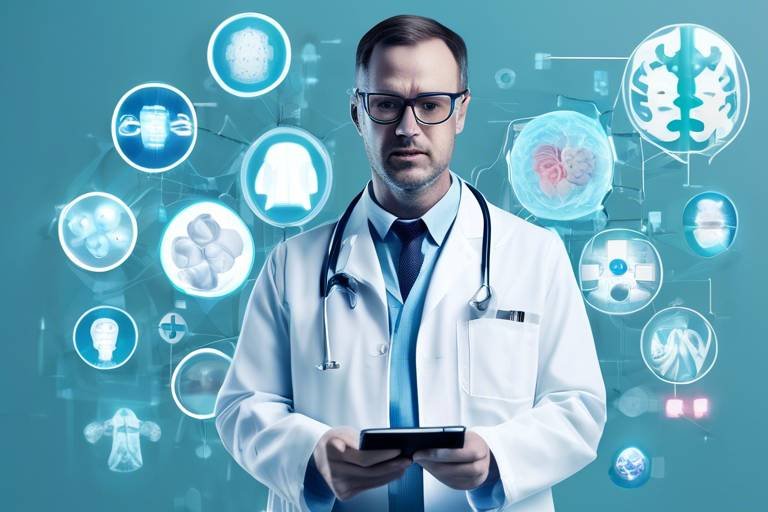How Artificial Intelligence is Influencing Healthcare Accessibility
The healthcare landscape is undergoing a dramatic transformation, and at the forefront of this revolution is artificial intelligence (AI). With its ability to process vast amounts of data and learn from it, AI is enhancing healthcare accessibility like never before. Imagine a world where patients in remote areas can receive expert medical advice without having to travel miles, where diagnostic tools are so precise that they can detect diseases in their earliest stages, and where healthcare systems operate more efficiently than ever. This is not just a dream; it's becoming a reality thanks to the innovative applications of AI.
One of the most exciting aspects of AI in healthcare is its potential to bridge the gap between patients and providers. Many individuals, especially those in underserved communities, face significant barriers to accessing quality healthcare. These barriers often include geographical constraints, lack of transportation, and limited availability of specialists. AI technologies are working to dismantle these obstacles by facilitating remote consultations, streamlining processes, and ultimately democratizing healthcare.
Moreover, AI is not just about making healthcare more accessible; it's also about enhancing the quality of care provided. By analyzing patient data and predicting outcomes, AI can help healthcare providers make informed decisions tailored to individual needs. This means that patients are not just receiving care; they are receiving personalized care that takes into account their unique circumstances. In this way, AI is not just a tool—it's a partner in healthcare, working alongside human expertise to create a more effective and equitable system.
As we delve deeper into the various ways AI is influencing healthcare accessibility, it becomes clear that its impact is both profound and far-reaching. From telemedicine to predictive analytics, AI is reshaping the very foundation of healthcare delivery. With each advancement, we move closer to a future where everyone has the opportunity to receive the care they need, when they need it, regardless of where they live.
- What is AI in healthcare?
AI in healthcare refers to the use of machine learning algorithms and other advanced technologies to analyze medical data, improve diagnostics, and enhance patient care.
- How does AI improve healthcare accessibility?
AI improves healthcare accessibility by enabling remote consultations, streamlining processes, and personalizing care for patients, especially in underserved areas.
- Can AI replace healthcare professionals?
No, AI is designed to assist healthcare professionals by providing them with tools and insights that enhance their decision-making, not to replace them.
- What are the risks associated with AI in healthcare?
While AI offers many benefits, risks include data privacy concerns, potential biases in algorithms, and the need for proper oversight to ensure safety and efficacy.

The Role of AI in Telemedicine
Telemedicine has undergone a remarkable transformation thanks to the integration of artificial intelligence (AI) technologies. Imagine being able to consult a healthcare professional from the comfort of your home, without the hassle of long waiting times or travel. Sounds like a dream, right? Well, AI is turning that dream into reality by enabling remote consultations that are not only efficient but also effective. This is particularly beneficial for patients in underserved areas, where access to healthcare facilities can be limited. By bridging the healthcare gap, AI is paving the way for a more inclusive health system.
One of the most significant advantages of AI in telemedicine is its ability to analyze vast amounts of data quickly. This capability allows healthcare providers to make informed decisions in real-time. For instance, AI can evaluate a patient's medical history, current symptoms, and even social determinants of health to provide tailored recommendations. This personalized approach ensures that patients receive the most appropriate care, regardless of their location.
Furthermore, AI-driven telemedicine platforms can facilitate virtual triage. This process involves assessing a patient's condition through a series of questions and algorithms, determining the urgency of their medical needs. By doing so, AI helps prioritize cases, ensuring that those who require immediate attention receive it without delay. This is especially crucial during times of crisis, such as a pandemic, when healthcare systems can become overwhelmed.
Another exciting aspect of AI in telemedicine is its potential for continuous monitoring. With the help of wearable devices and mobile applications, AI can track patients' vital signs and health metrics in real-time. This data can be analyzed to detect early warning signs of complications, enabling healthcare providers to intervene proactively. Imagine a world where your health is constantly monitored, and any anomalies are flagged before they become serious issues. That's the power of AI!
Moreover, the integration of AI in telemedicine is not just about enhancing patient care; it's also about improving the overall efficiency of healthcare systems. By automating routine tasks, such as appointment scheduling and follow-up reminders, AI frees up healthcare professionals to focus on what they do best: caring for patients. This leads to a more streamlined workflow and ultimately better patient outcomes.
To illustrate the impact of AI in telemedicine, consider the following table that highlights key benefits:
| Benefit | Description |
|---|---|
| Enhanced Access | Improves healthcare access for patients in remote or underserved areas. |
| Real-time Data Analysis | Enables informed decision-making through rapid analysis of patient data. |
| Virtual Triage | Prioritizes patient cases based on urgency, ensuring timely care. |
| Continuous Monitoring | Tracks vital signs and health metrics for proactive health management. |
| Operational Efficiency | Automates administrative tasks, allowing healthcare professionals to focus on patient care. |
In summary, the role of AI in telemedicine is multifaceted and transformative. By enhancing access, improving diagnostics, and streamlining processes, AI is not just a tool but a partner in revolutionizing healthcare delivery. As we continue to embrace these technologies, the future of healthcare looks brighter, more accessible, and more efficient than ever before.
- How does AI improve telemedicine? AI enhances telemedicine by enabling real-time data analysis, virtual triage, and continuous patient monitoring, leading to better outcomes.
- Can AI replace healthcare professionals? No, AI is designed to assist healthcare professionals, not replace them. It automates routine tasks, allowing providers to focus on patient care.
- Is telemedicine secure? Yes, most telemedicine platforms utilize advanced encryption and security measures to protect patient data and privacy.

AI-Driven Diagnostics
Artificial intelligence is not just a buzzword; it’s a game changer in the field of diagnostics. Imagine a world where diseases are detected earlier, treatments are more effective, and patient outcomes are significantly improved. This is the reality that AI is creating in healthcare. By rapidly analyzing vast amounts of medical data, AI enhances diagnostic accuracy, allowing healthcare professionals to make informed decisions faster than ever before. It’s like having a supercharged assistant who can sift through mountains of information in the blink of an eye, ensuring that no critical detail goes unnoticed.
One of the most exciting developments in AI-driven diagnostics is the use of machine learning algorithms in radiology. These algorithms are revolutionizing how radiologists interpret medical images. Think of it as having a trusty sidekick that can spot subtle patterns and anomalies in X-rays, MRIs, and CT scans that might elude even the most trained eyes. This partnership between human expertise and machine intelligence leads to quicker diagnoses and a reduced workload for healthcare providers, all while maintaining the highest standards of accuracy.
Machine learning algorithms are designed to learn from data, improving their performance over time. In the context of radiology, they analyze thousands of images to identify what healthy tissue looks like versus what indicates disease. This is particularly crucial in conditions like cancer, where early detection can be the difference between life and death. With AI's assistance, radiologists can focus more on patient interaction and less on the tedious task of image analysis.
AI tools enhance image analysis by employing deep learning techniques that mimic the way humans learn. These tools are trained on extensive datasets, allowing them to recognize complex patterns that might be missed by the human eye. For instance, AI can identify minute changes in tissue structure that could indicate the early stages of a disease, providing a safety net that can significantly improve patient outcomes. It’s like having a magnifying glass that reveals tiny details, ensuring more reliable results in diagnostic imaging.
Integrating AI with traditional radiology methods creates a comprehensive approach to diagnostics. While AI can analyze images with speed and precision, the human touch remains irreplaceable. The combination of AI's analytical prowess and the radiologist's clinical judgment leads to optimal patient care. This synergy not only enhances diagnostic accuracy but also fosters a collaborative environment where technology and human expertise work hand in hand.
Beyond diagnostics, AI's predictive analytics capabilities are reshaping how healthcare providers approach patient care. By analyzing historical data, AI can forecast patient outcomes, allowing healthcare professionals to tailor interventions to meet the unique needs of diverse populations. It’s akin to having a crystal ball that helps predict future health scenarios, enabling proactive measures that can significantly improve the quality of care.
In summary, AI-driven diagnostics are not just about speed; they are about enhancing the quality of care delivered to patients. With advancements in machine learning and image analysis, healthcare providers can make more informed decisions, ultimately leading to better health outcomes. As we continue to embrace these technological innovations, the future of healthcare looks brighter and more accessible than ever before.
- What is AI-driven diagnostics? AI-driven diagnostics refers to the use of artificial intelligence technologies to analyze medical data and images, enhancing the accuracy and speed of disease detection.
- How does AI improve radiology? AI improves radiology by assisting radiologists in interpreting medical images, identifying patterns and anomalies that may be missed by the human eye.
- Can AI replace human radiologists? No, AI is designed to assist radiologists, not replace them. The combination of AI’s analytical capabilities and human expertise leads to better patient care.
- What are the benefits of predictive analytics in healthcare? Predictive analytics helps forecast patient outcomes, allowing for tailored interventions that improve the quality of care and health outcomes.

Machine Learning Algorithms in Radiology
Machine learning algorithms are truly revolutionizing the field of radiology, acting as a powerful ally to radiologists in their quest for accurate diagnoses. Imagine a world where the mountains of medical images—like X-rays, MRIs, and CT scans—can be analyzed faster and more accurately than ever before. This is not just a dream; it's becoming a reality thanks to the advancements in artificial intelligence. By leveraging vast amounts of data, these algorithms can identify patterns and anomalies that may elude even the most experienced eyes. This capability is particularly vital in a field where even a small oversight can lead to significant consequences for patient care.
One of the standout features of machine learning in radiology is its ability to learn from previous cases. The algorithms are trained on extensive datasets, allowing them to improve their accuracy over time. For example, when presented with thousands of chest X-rays, a machine learning model can learn to differentiate between healthy lungs and those affected by conditions such as pneumonia or lung cancer. This not only speeds up the diagnostic process but also enhances the reliability of the results. The integration of these advanced technologies into clinical practice is akin to having a highly skilled assistant who never tires and continuously learns from every case.
Moreover, the collaboration between machine learning algorithms and radiologists is fostering a new era of healthcare. Rather than replacing human expertise, these algorithms complement it. By handling the more mundane aspects of image analysis, they allow radiologists to focus on complex cases that require nuanced judgment and experience. This partnership leads to quicker turnaround times for patients awaiting results, which is crucial in urgent situations where every moment counts. As a result, the healthcare system becomes more efficient, and patients receive timely interventions that can significantly improve their outcomes.
To illustrate the impact of machine learning algorithms in radiology, consider the following table that summarizes key benefits:
| Benefit | Description |
|---|---|
| Increased Accuracy | Algorithms can detect subtle changes in images, leading to earlier diagnosis of diseases. |
| Reduced Workload | Automating routine analyses allows radiologists to concentrate on more complex cases. |
| Faster Diagnoses | Quicker analysis of images can lead to timely treatment decisions. |
| Continuous Learning | Machine learning models improve over time as they are exposed to more data. |
In conclusion, the integration of machine learning algorithms in radiology is not just a technological advancement; it represents a fundamental shift in how we approach medical imaging. By enhancing diagnostic accuracy, reducing workloads, and improving patient outcomes, these algorithms are making healthcare more accessible and efficient. As we continue to explore the potential of AI in this field, the future looks promising. Radiologists and patients alike can look forward to a healthcare environment where technology and human expertise work hand in hand to deliver the best possible care.
- What are machine learning algorithms? Machine learning algorithms are computational models that learn from data to make predictions or decisions without being explicitly programmed.
- How do these algorithms improve radiology? They enhance radiology by analyzing medical images quickly and accurately, helping to identify conditions that may be overlooked by human eyes.
- Are radiologists replaced by AI? No, AI complements radiologists by handling routine analyses, allowing them to focus on more complex cases that require human judgment.
- What is the future of AI in healthcare? The future is promising, with AI expected to play a crucial role in improving diagnostics, patient outcomes, and overall healthcare efficiency.

Enhancing Image Analysis
In today's fast-paced world, the ability to quickly and accurately analyze medical images is crucial for effective patient care. Artificial Intelligence (AI) has emerged as a game-changer in this domain, significantly enhancing the way healthcare professionals interpret imaging data. By leveraging advanced algorithms, AI tools can sift through vast amounts of data, identifying patterns and anomalies that might elude even the most experienced radiologists.
Imagine having a tireless assistant that can analyze thousands of images in a fraction of the time it would take a human. This is precisely what AI offers. It not only accelerates the diagnostic process but also improves the accuracy of results. For instance, studies have shown that AI can outperform human experts in detecting certain conditions, such as tumors or fractures, thereby ensuring that patients receive timely and appropriate care.
Moreover, AI's ability to enhance image analysis is not limited to just identifying issues; it also plays a vital role in predicting patient outcomes. By correlating imaging data with historical patient records, AI can help healthcare providers anticipate complications and tailor treatment plans accordingly. This predictive capability is especially beneficial in complex cases where multiple factors must be considered.
One of the most exciting aspects of AI in image analysis is its integration with traditional radiology methods. Rather than replacing human expertise, AI complements it. By providing radiologists with advanced tools for image interpretation, the technology fosters a collaborative environment where both AI and human insights work in tandem. This synergy not only enhances diagnostic accuracy but also reduces the workload for radiologists, allowing them to focus on more complex cases that require human judgment.
In summary, the enhancement of image analysis through AI is reshaping the landscape of medical diagnostics. With its ability to improve detection rates, predict outcomes, and integrate seamlessly with traditional practices, AI is paving the way for a future where healthcare is more efficient, accurate, and accessible to all.
- What types of medical images can AI analyze? AI can analyze various types of medical images, including X-rays, MRIs, CT scans, and ultrasounds.
- How does AI improve diagnostic accuracy? AI improves diagnostic accuracy by utilizing machine learning algorithms to identify patterns and anomalies that may be missed by the human eye.
- Is AI meant to replace radiologists? No, AI is designed to assist radiologists, enhancing their capabilities and allowing them to focus on more complex cases.
- What are the benefits of integrating AI with traditional radiology? The integration of AI with traditional methods leads to faster diagnoses, improved accuracy, and reduced workload for radiologists.

Integration with Traditional Methods
The integration of artificial intelligence (AI) with traditional radiology methods marks a significant leap forward in the medical field. Imagine the synergy created when seasoned radiologists team up with advanced AI algorithms; it’s like having a highly skilled co-pilot assisting a seasoned pilot in navigating through complex airspace. This collaboration not only enhances the accuracy of diagnoses but also streamlines the entire workflow within medical facilities.
AI technologies are designed to complement the expertise of healthcare professionals, ensuring that the human touch remains at the forefront of patient care. By analyzing vast amounts of data and identifying patterns that might be overlooked, AI tools can flag potential issues for further investigation. For instance, in a busy radiology department, an AI system can quickly analyze hundreds of X-rays, highlighting any abnormalities that need immediate attention. This allows radiologists to focus on cases that require their expertise the most, thereby improving efficiency and reducing burnout.
Moreover, the integration of AI with traditional methods facilitates a more comprehensive approach to diagnostics. In the past, radiologists relied heavily on their training and experience to interpret images, which, while effective, could sometimes lead to human error. Now, with AI’s ability to process and analyze images rapidly, there is a double-checking mechanism in place. This not only enhances the reliability of results but also boosts the confidence of healthcare providers in their diagnostic capabilities.
Another critical aspect of this integration is the continuous learning process that AI systems undergo. As they analyze more data, they improve their algorithms, which means that the more they work alongside traditional methods, the better they get at assisting radiologists. This creates a feedback loop where both human and machine learn from each other, ultimately leading to better patient outcomes.
In conclusion, the integration of AI with traditional radiology methods is not about replacing human expertise; rather, it’s about enhancing it. By combining the best of both worlds, healthcare providers can offer more accurate diagnoses, reduce workloads, and ultimately improve patient care. This harmonious relationship between AI and traditional practices is paving the way for a new era in healthcare, where technology and human skill go hand in hand.
- How does AI improve diagnostic accuracy?
AI algorithms analyze large datasets quickly, identifying patterns and anomalies that may escape human observation, leading to more accurate diagnoses. - Can AI replace radiologists?
No, AI is designed to assist radiologists, not replace them. It enhances their capabilities and allows them to focus on more complex cases. - What are the benefits of integrating AI with traditional methods?
The integration leads to improved accuracy, reduced workload, and enhanced patient care through a collaborative approach. - How does AI learn from traditional radiology methods?
AI systems learn by analyzing data and outcomes, continuously refining their algorithms to improve their diagnostic capabilities over time.

Predictive Analytics for Patient Outcomes
Imagine walking into a doctor’s office, and instead of just getting a general check-up, your physician already knows the likelihood of various health issues you might face in the future. This is the power of predictive analytics in healthcare. By harnessing the vast amounts of data generated from patient records, wearable devices, and even social determinants of health, healthcare providers can forecast patient outcomes with remarkable accuracy. This not only helps in tailoring interventions but also leads to improved quality of care.
Predictive analytics utilizes sophisticated algorithms and machine learning models to analyze historical data and recognize patterns that may indicate future health events. For instance, by examining data such as age, medical history, lifestyle choices, and even genetic factors, AI can predict which patients are at higher risk for conditions like diabetes, heart disease, or even mental health disorders. This proactive approach allows for early intervention strategies, which can significantly alter the trajectory of a patient’s health.
Moreover, the implementation of predictive analytics can lead to more personalized treatment plans. When healthcare providers can anticipate potential health risks, they can customize treatment regimens that align with the unique needs of each patient. This not only enhances patient satisfaction but also fosters a sense of empowerment, as patients become active participants in their own healthcare journey.
One of the most exciting aspects of predictive analytics is its ability to reduce hospital readmissions. By identifying patients who are at risk of returning to the hospital after discharge, healthcare teams can implement targeted follow-up care and support, ensuring that patients receive the necessary resources to manage their conditions effectively. This not only improves patient outcomes but also reduces the strain on healthcare systems, ultimately leading to cost savings.
In a nutshell, predictive analytics is revolutionizing the way healthcare providers approach patient care. It transforms data into actionable insights, enabling a shift from reactive to proactive healthcare. With the ongoing advancements in AI and machine learning, the potential for improving patient outcomes is immense, and we are only beginning to scratch the surface of what is possible.
- What is predictive analytics in healthcare? Predictive analytics in healthcare involves using data, statistical algorithms, and machine learning techniques to identify the likelihood of future outcomes based on historical data.
- How does predictive analytics improve patient care? By forecasting potential health issues, healthcare providers can tailor interventions and treatment plans to better meet individual patient needs, leading to improved health outcomes.
- Can predictive analytics reduce healthcare costs? Yes, by preventing complications and reducing hospital readmissions through targeted interventions, predictive analytics can lead to significant cost savings for healthcare systems.
- Is patient data safe when using predictive analytics? Yes, reputable healthcare organizations implement strict data protection measures to ensure patient privacy and security while using predictive analytics.

Improving Patient Engagement
In today's fast-paced world, patient engagement has become a cornerstone of effective healthcare. With the rise of artificial intelligence (AI), there are innovative ways to foster a stronger connection between patients and their healthcare providers. Imagine having a personal health assistant available 24/7, ready to answer your questions and provide tailored advice. That's the power of AI in enhancing patient engagement!
AI technologies are revolutionizing how patients interact with their healthcare systems. For instance, personalized health information is just a click away, thanks to AI-driven platforms that analyze individual health data. This means that patients can receive customized recommendations based on their unique health profiles. It's like having a personal trainer who knows your fitness goals and dietary needs, but in the realm of health management.
Furthermore, reminders and support systems powered by AI can significantly improve treatment adherence. With automated messages reminding patients to take their medications or attend appointments, the likelihood of compliance increases. Consider this: how often do we forget to take a pill or miss a follow-up? AI can act as a gentle nudge, ensuring that patients stay on track with their health regimens.
One of the most exciting developments in this arena is the use of chatbots and virtual assistants. These AI-driven tools provide real-time assistance, answering questions and resolving concerns instantly. Patients can inquire about symptoms, schedule appointments, or even access their medical records without the hassle of waiting on hold for a human representative. This not only enhances accessibility but also boosts patient satisfaction. After all, who enjoys being put on hold?
To illustrate the impact of AI on patient engagement, let's take a look at some key benefits:
| Benefit | Description |
|---|---|
| 24/7 Availability | Patients can access information and support anytime, anywhere. |
| Personalized Care | Recommendations and reminders tailored to individual health needs. |
| Improved Compliance | Automated reminders help patients adhere to treatment plans. |
| Instant Support | Chatbots provide immediate answers, reducing wait times. |
As we delve deeper into the potential of AI in healthcare, it's clear that enhancing patient engagement is just the tip of the iceberg. By empowering patients with knowledge and support, we not only improve individual health outcomes but also foster a more collaborative healthcare environment. After all, when patients are engaged, they are more likely to take charge of their health, leading to better results for everyone involved.
In summary, AI is reshaping the landscape of patient engagement by offering innovative solutions that make healthcare more accessible and personalized. Whether through chatbots, tailored recommendations, or automated reminders, the future of patient engagement looks bright and promising. Are you ready to embrace this change?
- What is patient engagement? - Patient engagement refers to the involvement of patients in their own healthcare, including decision-making and management of their health.
- How does AI improve patient engagement? - AI enhances patient engagement by providing personalized information, reminders, and real-time support through tools like chatbots and virtual assistants.
- Can AI help with medication adherence? - Yes, AI can send automated reminders to patients about their medications, improving adherence rates.
- Are chatbots reliable for healthcare information? - While chatbots can provide useful information, they should not replace professional medical advice. Always consult a healthcare provider for serious concerns.

Chatbots and Virtual Assistants
In the rapidly evolving landscape of healthcare, are emerging as game-changers, transforming how patients interact with medical services. Imagine having a personal health assistant available 24/7, ready to answer your questions, remind you about medications, or even help schedule appointments. This is no longer a futuristic dream; it’s the reality that AI technology has made possible. These digital companions can handle a myriad of tasks, ensuring that patients receive timely support and information without the need for direct human interaction.
One of the most significant advantages of chatbots in healthcare is their ability to enhance accessibility. For patients in remote or underserved areas, where healthcare professionals may be scarce, these virtual assistants provide a crucial link to medical advice and support. By simply texting or using a voice command, individuals can receive immediate responses to their health inquiries, thus reducing the barriers that often hinder access to essential healthcare services.
Additionally, chatbots can be programmed to handle a variety of tasks, including:
- Appointment Scheduling: Patients can easily book, change, or cancel appointments without needing to speak to a receptionist.
- Medication Reminders: Virtual assistants can send timely notifications to patients, ensuring they take their medications as prescribed.
- Symptom Assessment: By asking a series of questions, chatbots can help evaluate symptoms and suggest whether a doctor’s visit is necessary.
Moreover, the integration of chatbots into healthcare systems not only improves patient engagement but also reduces the workload on healthcare staff. This allows professionals to focus on more complex patient needs while routine inquiries are managed by AI. The efficiency brought by these technologies is akin to having a well-oiled machine working tirelessly in the background, ensuring that everything runs smoothly.
However, it’s essential to recognize that while chatbots and virtual assistants are incredibly useful, they are not intended to replace human interaction. Instead, they serve as a complementary resource that enhances the overall patient experience. By handling routine tasks, they free up healthcare providers to spend more quality time with patients, addressing their specific concerns and needs.
In conclusion, chatbots and virtual assistants represent a significant leap forward in healthcare accessibility. They not only empower patients by providing them with the information and support they need but also streamline operations within healthcare facilities. As technology continues to advance, we can expect these digital tools to become even more sophisticated, further enhancing the patient experience and making healthcare more accessible for everyone.
Here are some common questions regarding chatbots and virtual assistants in healthcare:
- What are chatbots? Chatbots are AI-powered tools that can communicate with users via text or voice, providing information and assistance.
- How do virtual assistants improve healthcare? They enhance patient engagement, streamline appointment scheduling, and provide timely health information.
- Can chatbots replace doctors? No, they are designed to assist and complement healthcare providers, not replace them.
- Are chatbots secure? Most healthcare chatbots are built with security measures to protect patient data, but it's essential to verify the security features of any chatbot you use.

Personalized Health Recommendations
In today's fast-paced world, where every individual has unique health needs and challenges, the emergence of AI-driven platforms for personalized health recommendations is nothing short of revolutionary. Imagine having a virtual health coach that understands your medical history, lifestyle choices, and even your preferences for diet and exercise. This is the power of artificial intelligence—transforming the way we approach our health.
AI systems analyze a vast array of data, including genetic information, medical records, and even real-time health metrics from wearable devices. By synthesizing this information, they can provide tailored recommendations that cater to the specific needs of each individual. For instance, if you have a family history of diabetes, the AI can suggest dietary changes and exercise routines that not only help in managing your weight but also lower your risk of developing the condition.
Moreover, these personalized recommendations are not static; they evolve as your health status changes. If you start a new medication or experience a significant life event, the AI can reassess your situation and adjust its suggestions accordingly. This dynamic approach ensures that you are always receiving the most relevant advice. It's like having a personal trainer, nutritionist, and medical advisor all rolled into one, available at your fingertips!
But how does this actually work in practice? Let’s break it down:
- Data Collection: The first step involves gathering comprehensive data about the individual. This includes medical history, lifestyle habits, and preferences.
- Analysis: Advanced algorithms analyze the collected data to identify patterns and correlations that may not be immediately apparent.
- Recommendation Generation: Based on the analysis, the system generates personalized health recommendations, which can range from dietary suggestions to exercise plans.
- Feedback Loop: Users can provide feedback on the effectiveness of the recommendations, allowing the AI to refine its suggestions over time.
One of the most exciting aspects of personalized health recommendations is their potential to enhance patient engagement. When individuals feel that their health management is tailored specifically to them, they are more likely to adhere to the advice provided. This not only leads to better health outcomes but also empowers patients to take an active role in their health journey.
As healthcare continues to evolve, the integration of AI in providing personalized health recommendations will play a pivotal role in shaping a more proactive and engaged patient population. The future of healthcare is not just about treating illness; it's about empowering individuals to lead healthier lives through informed choices and tailored guidance.
1. How does AI provide personalized health recommendations?
AI analyzes individual health data, including medical history and lifestyle choices, to generate tailored recommendations aimed at improving health outcomes.
2. Can personalized health recommendations change over time?
Yes, AI systems continuously learn and adapt based on new data and user feedback, ensuring that recommendations remain relevant as health conditions evolve.
3. Are AI-driven health recommendations safe?
AI recommendations are based on extensive data analysis and are designed to complement, not replace, professional medical advice. Always consult with a healthcare provider for medical decisions.
4. How can I access AI-driven personalized health recommendations?
Many health apps and platforms now incorporate AI technology to provide personalized health insights. Look for reputable services that prioritize data security and user privacy.

Addressing Healthcare Inequities
In today's world, where technology is advancing at lightning speed, one of the most promising applications of artificial intelligence (AI) is its potential to address healthcare inequities. The reality is, many individuals from marginalized communities face significant barriers to accessing quality healthcare. But what if AI could help level the playing field? By identifying at-risk populations and tailoring interventions to meet their specific needs, AI has the potential to foster a more equitable healthcare system.
One of the most effective ways AI can address these disparities is through data analysis. AI algorithms can sift through vast amounts of healthcare data, uncovering patterns that may not be visible to the naked eye. For instance, they can identify which communities are most affected by certain diseases, allowing healthcare providers to allocate resources more effectively. Imagine a scenario where a community with a high prevalence of diabetes receives targeted outreach programs and health services tailored to their specific needs. This is not just a dream; it's a reality that AI can help create.
Furthermore, AI can support community health initiatives by identifying trends and needs within populations. For example, if data shows a spike in mental health issues in a specific area, healthcare organizations can mobilize resources to address this urgent need. This proactive approach can lead to timely interventions that improve health outcomes significantly. It's like having a highly skilled detective, sifting through clues to solve a mystery, but in this case, the mystery is understanding and addressing the health needs of a community.
Additionally, AI can play a crucial role in enhancing outreach efforts. By analyzing demographic data, AI can help healthcare organizations develop targeted campaigns that resonate with specific communities. This means that information about available services can be disseminated in a way that is culturally sensitive and accessible. For instance, using local languages or community influencers can make a world of difference in how health messages are received.
To summarize, the integration of AI in addressing healthcare inequities is not just about technology; it's about creating a fairer system where everyone has access to the care they need. By leveraging data analysis, supporting community initiatives, and enhancing outreach efforts, AI holds the key to unlocking a healthier future for all. It's an exciting time in healthcare, and with the right tools, we can make significant strides toward equality.
- How does AI help in identifying at-risk populations?
AI analyzes healthcare data and identifies patterns that indicate which populations are most vulnerable to certain health issues, allowing for targeted interventions. - Can AI improve resource allocation in healthcare?
Yes, AI algorithms can optimize resource allocation by analyzing data to ensure that underserved communities receive the necessary support and services. - What role does community health play in addressing inequities?
Community health initiatives supported by AI can identify trends and needs within populations, enabling targeted interventions that effectively address local health challenges.

Data Analysis for Resource Allocation
In the quest for a more equitable healthcare system, data analysis plays a pivotal role in optimizing resource allocation. By leveraging artificial intelligence, healthcare providers can sift through vast amounts of data to identify trends, needs, and gaps in services. This process is not merely about crunching numbers; it’s about understanding the stories behind the data. For instance, AI can analyze demographics, disease prevalence, and socioeconomic factors to pinpoint at-risk populations that may require additional support.
Imagine a small town where a sudden spike in respiratory illnesses is reported. Traditional methods might take time to recognize this trend, but with AI-driven data analysis, healthcare providers can swiftly identify the outbreak, determine its cause, and allocate resources like medical staff, equipment, and medication right where they are needed most. This proactive approach not only saves lives but also enhances the overall efficiency of the healthcare system.
Moreover, AI can help in the strategic planning of healthcare services by predicting future healthcare needs based on historical data. For example, if data shows a rising trend in diabetes cases in a specific region, healthcare authorities can prepare by ensuring that sufficient resources, such as endocrinologists and diabetes education programs, are available. This not only improves patient outcomes but also reduces long-term costs associated with unmanaged health conditions.
To illustrate the impact of data analysis on resource allocation, consider the following table:
| Region | Health Issue | Recommended Resources | Projected Impact |
|---|---|---|---|
| Urban Area | Obesity | Nutrition Programs, Exercise Classes | Reduced obesity rates by 15% |
| Rural Area | Diabetes | Mobile Clinics, Education Workshops | Improved management of diabetes |
| Low-Income Neighborhood | Mental Health | Counseling Services, Support Groups | Increased access to mental health care |
This table exemplifies how targeted resource allocation, driven by data analysis, can lead to significant improvements in health outcomes. By understanding the specific needs of different communities, healthcare providers can implement tailored strategies that address local health challenges effectively. Ultimately, the fusion of AI technology and data analysis not only enhances service delivery but also fosters a healthier society.
- How does AI improve healthcare resource allocation?
AI analyzes large datasets to identify health trends and allocate resources where they are most needed, ensuring efficient use of healthcare services. - What types of data are analyzed for resource allocation?
Factors such as demographics, disease prevalence, socioeconomic status, and historical health data are considered to inform resource distribution. - Can AI help predict future healthcare needs?
Yes, AI can use historical data to forecast future healthcare demands, allowing for proactive planning and resource allocation. - What is the impact of targeted resource allocation?
Targeted allocation leads to improved health outcomes, reduced healthcare costs, and enhanced access to necessary services for at-risk populations.

Community Health Initiatives
Community health initiatives are vital for addressing the unique health challenges faced by specific populations. With the advent of artificial intelligence, these initiatives have gained a powerful ally. AI can analyze vast amounts of data to identify trends and health disparities within communities, allowing healthcare providers to tailor their interventions effectively. Imagine a community where healthcare is not just reactive but proactive, where services are designed based on the actual needs of the population rather than generalized assumptions.
One of the most exciting aspects of AI in community health is its ability to uncover hidden patterns in health data. For instance, AI can analyze social determinants of health such as income, education, and access to transportation, helping organizations pinpoint at-risk populations. By doing so, healthcare providers can create targeted outreach programs that focus on preventive care, education, and resources tailored to those who need them most.
Moreover, AI can streamline the process of community health assessments. Traditionally, these assessments required extensive manual data collection and analysis, often resulting in outdated or incomplete information. With AI, organizations can leverage real-time data analytics to continuously monitor community health, making adjustments to programs as needed. This agility ensures that interventions remain relevant and effective.
For example, consider a community struggling with high rates of diabetes. AI can help identify which neighborhoods are most affected and what factors contribute to these rates. By analyzing data, healthcare providers can implement initiatives such as:
- Community fitness programs tailored to local needs
- Nutrition workshops that focus on affordable, healthy eating
- Mobile health units that provide screenings and education
These targeted initiatives not only improve health outcomes but also foster a sense of community engagement and empowerment. Residents become active participants in their health journeys, leading to a more informed and healthier population overall.
To illustrate the impact of AI-driven community health initiatives, consider the following table:
| Community | Health Issue Identified | AI-Driven Initiative | Expected Outcome |
|---|---|---|---|
| Neighborhood A | High obesity rates | Fitness programs and healthy cooking classes | Reduction in obesity rates by 15% over 2 years |
| Neighborhood B | High diabetes prevalence | Mobile health screenings and education | Improved management of diabetes and lower hospitalization rates |
| Neighborhood C | High mental health issues | Community support groups and access to teletherapy | Increased access to mental health resources and reduced stigma |
In conclusion, the integration of AI into community health initiatives is not just a trend; it’s a transformative approach to healthcare. By harnessing the power of data, we can create healthier, more equitable communities. As we look to the future, the potential for AI to shape community health is immense, promising a world where every individual has access to the care they need, when they need it.
Q: How does AI improve community health initiatives?
A: AI enhances community health initiatives by analyzing data to identify health trends and disparities, enabling targeted interventions that address specific needs within populations.
Q: What types of data does AI analyze for community health?
A: AI analyzes various data types, including health outcomes, social determinants of health, demographic information, and access to healthcare services.
Q: Can AI help in real-time monitoring of community health?
A: Yes, AI can provide real-time analytics, allowing healthcare providers to adjust their initiatives based on current community health data.
Q: Are AI-driven initiatives cost-effective?
A: While there may be initial costs associated with implementing AI technology, the long-term benefits, including improved health outcomes and reduced healthcare costs, often outweigh these expenses.
Frequently Asked Questions
- How is AI improving healthcare accessibility?
AI is transforming healthcare accessibility by enabling telemedicine, enhancing diagnostics, and personalizing patient engagement. By utilizing advanced algorithms, AI helps bridge the gap for underserved populations, ensuring they receive timely care and support.
- What role does AI play in telemedicine?
AI enhances telemedicine by facilitating remote consultations and improving communication between patients and healthcare providers. This technology ensures that individuals in remote or underserved areas can access medical advice and care without the need to travel long distances.
- How does AI improve diagnostic accuracy?
AI improves diagnostic accuracy by rapidly analyzing vast amounts of medical data, leading to earlier disease detection. This capability allows healthcare professionals to make informed decisions quickly, ultimately improving treatment outcomes for patients.
- Can AI assist in radiology?
Absolutely! AI-driven machine learning algorithms assist radiologists by interpreting medical images more efficiently. They identify patterns and anomalies that might be missed by the human eye, which enhances the overall accuracy and speed of diagnoses.
- What are predictive analytics in healthcare?
Predictive analytics uses AI to forecast patient outcomes based on historical data. This information helps healthcare providers tailor interventions, ensuring that they can deliver personalized care that meets the specific needs of diverse populations.
- How do AI chatbots benefit patients?
AI chatbots provide real-time assistance, answering patient queries and offering health information. This immediate support increases patient satisfaction and engagement, making healthcare more accessible and user-friendly.
- What is the significance of personalized health recommendations?
Personalized health recommendations, powered by AI, analyze individual health data to provide tailored advice. This encourages proactive health management, helping patients adhere to treatment plans and make informed decisions about their health.
- How does AI address healthcare inequities?
AI addresses healthcare inequities by identifying at-risk populations and tailoring interventions to meet their unique needs. By analyzing healthcare data, AI ensures that underserved communities receive the necessary resources and support for improved health outcomes.
- Can AI support community health initiatives?
Yes! AI can significantly support community health initiatives by analyzing trends and identifying needs within specific populations. This enables targeted interventions that effectively address local health challenges, fostering a healthier community overall.



















